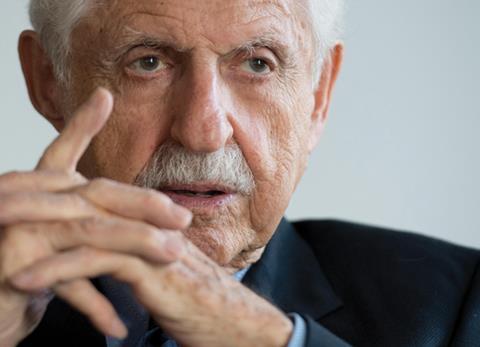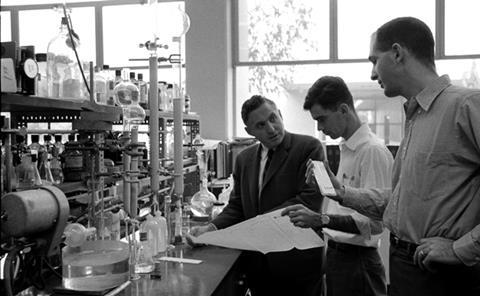Carl Djerassi leaves many legacies besides the contraceptive pill,says Mark Peplow

In the last few months of 2014, Carl Djerassi’s diary was packed. First he was in France for a discussion about the future of sex and reproduction; then in San Francisco, US, to see two of his plays performed. After a few more days in France, the next stop was Cambridge, UK, to launch his fourth autobiography, then Germany to give a lecture on artist Paul Klee and finally Austria, for more lectures and a TV appearance. He also found time to celebrate his 91st birthday during this frenetic schedule, and all while suffering from liver and bone cancer.
‘I’m basically an extremely curious person,’ Djerassi told Chemistry World last year. That curiosity – fueled by boundless energy – remained undimmed right up until his death on 30 January.
Djerassi freely admitted that he was a workaholic, and described himself as a ‘professional and intellectual polygamist’. Colleagues certainly remember him as intensely focused, determined and impatient, but also debonair and charming. With his neatly trimmed beard, coiffed white hair, accented yet precise English, he was the very model of a European gentleman-intellectual.
As a chemist, his pioneering work on the contraceptive pill has affected millions of people around the world. As a mentor, he inspired thousands of students and colleagues over five decades at Stanford University, US, publishing more than 1200 academic papers on analytical methods in organic chemistry, marine natural products and more. And as a writer, his plays, novels and memoirs held up a mirror to his own profession, unflinchingly exploring its obsession with priority, and the powerful role of ego and ambition in scientific discovery.
Steroid adventures
Djerassi was born in Vienna, Austria, on 29 October 1923. His father Samuel was a physician who specialised in sexual health, and his mother, Alice, was a dentist. As Jews, the family fled the country shortly after Nazi Germany annexed Austria in 1938; mother and son made it to the US the following year.

After completing a chemistry degree at Kenyon College, Ohio, in 1942, Djerassi took a job with Swiss pharmaceutical company Ciba, where he helped to develop one of the first antihistamine drugs, tripelennamine (now sold by Novartis as Pyribenzamine). Fascinated by research, he completed a PhD at the University of Wisconsin·Madison in 1945, before returning to Ciba.
But in 1949, the ambitious Djerassi took a leap of faith: a research job at Syntex, a small company based in Mexico City. Syntex had developed a low-cost synthesis of progesterone from diosgenin, a steroid extracted from the Mexican yam Dioscorea Mexicana. At that time, progesterone injections were being used to treat menstrual disorders and infertility.
Djerassi was charged with turning diosgenin into a much more valuable product: the anti-inflammatory cortisone, already being produced in a lengthy process by Merck & Co. In 1951, Djerassi and his colleagues worked out a much shorter 20-step synthesis, beating rivals including Robert Woodward and Louis Fieser at Harvard University.
The same year also saw his landmark work on contraceptive hormones. Scientists already knew that oestrogen and progesterone could halt ovulation, but daily injections were an impractical form of birth control. Djerassi’s team synthesised a progesterone mimic, 19-nor-17a-ethynyltestosterone, also known as norethisterone or norethindrone, which could be taken orally.
Two years later, drugmaker G D Searle developed norethynodrel, an isomer of norethindrone. Both formulations also contained traces of mestranol, a methyl ether of ethinylestradiol, which seemed to boost their activity.
In 1957, the US Food and Drug Administration approved all three steroids as oral treatments for ‘gynaecological disorders’. Three years later, G D Searle won approval for its contraceptive Enovid (a mixture of norethynodrel and mestranol). Syntex’s norethindrone·mestranol blend, Novum, was launched in 1962, and a low-dose version released in 1964 subsequently became the most widely used version of the contraceptive pill.
Today, more than 150 million women around the world use hormone contraceptives. They have given women control over their own fertility, and helped couples to control the size of their families. But the pill is not without its detractors. Some argue it pushed the burden of sexual responsibility onto women, who also had to bear the downsides of hormone contraception – the risk (albeit very small) of thrombosis and breast cancer. More recently, there have been concerns about the role of contraceptive hormones as endocrine disruptors in the environment, although their contribution is probably tiny compared with other endocrine disruptors.
Djerassi firmly believed that the pill’s benefits far outweighed any risks, pointing to the countless abortions and unwanted children it has helped to avoid. But he also admitted that the pill was not the trigger of the sexual revolution of the 1960s, as is sometimes claimed. Changing social attitudes towards sex, and women’s status in the workplace, did much more to drive that revolution, although the pill may have accelerated it.
From science to art
Djerassi’s busy years at Syntex coincided with tumult in his personal life. He and his first wife divorced in 1950, after an affair with Norma Lundholm resulted in pregnancy (ironically, he explained, ‘the condom broke’). He married Lundholm soon after, and had a daughter, Pamela, and a son, Dale.
He moved to Stanford University in California in 1959, where he developed synthetic hormones that could stop insects from maturing, co-founding the company Zoecon to commercialise the idea in 1968. One of its products, methoprene, became widely used as a mosquito larvicide that has helped to control the spread of West Nile virus.
He also studied the synthesis of marine natural products, and pioneered methods in organic chemistry, including magnetic circular dichroism, optical rotatory dispersion and various mass spectrometry techniques. In the late 1960s, he helped to develop a computer program, Dendral, which assisted chemists in working out the structures of natural products.

Despite his own workaholic tendencies, he disliked the culture that expected graduate students to work 70- or 80-hour weeks, calling it ‘a form of voluntary slavery’. Students and colleagues have also noted his progressive hiring practices, bringing women into his lab at a time when they were hugely underrepresented in science.
With his commercial research came personal wealth, allowing him to expand his intellectual horizons. He became a collector of fine art, with a particular passion for the work of Paul Klee. Perhaps inspired by her father’s interests, Djerassi’s daughter Pamela became an artist.
Her suicide in 1978 was devastating for Djerassi. Suffering from severe depression, Pamela had left a note and disappeared into the woods on his 1200 acre property in California. Djerassi himself found her body, four days later. He subsequently established an artist’s retreat on his ranch in her memory, which has provided studio space for more than 2000 visiting artists over the years.
In interviews years after Pamela’s suicide, he recalled the circumstances and his own emotional response in a detached, almost clinical way · using his scientific mind to dissect the tragedy. That analytical approach to complex human questions became a defining feature of his work when, in 1992, he closed his Stanford research laboratories to focus on his career as a writer.
The intellectual smuggler
Djerassi had been writing poetry since the mid-1980s. Memoirs and novels followed, but in 1996 Djerassi was inspired to become a playwright on seeing Stephen Poliakoff’s dramatisation of the cold-fusion controversy, Blinded by the Sun. His goal was to be an ‘intellectual smuggler’ – hiding his ideas about science and the scientific process in plain sight, all wrapped in compelling dramas.
In 1998, his first ‘science in fiction’ play, An immaculate misconception, unpicked the moral and societal challenges of medical technologies that separate sex from reproduction. Ultimately, he speculated, sex would become an entirely recreational activity, with all reproduction conducted by artificial insemination.
His second play, Oxygen, co-authored with Roald Hoffmann, imagined a debate about whether to award a ‘retro Nobel’ to Carl Scheele, Joseph Priestley or Antoine Lavoisier for discovering oxygen. This question of priority is a central feature of science, he said: ‘In my view, it is the most collegial discipline, and at the same time the most ruthlessly competitive.’
Many of his subsequent plays and novels dealt with credit, priority and reward in science. It was clearly close to his heart: he never won a Nobel prize for his work, although he often featured on the tip sheets that routinely do the rounds before the annual announcements from Stockholm.
However, he won pretty much every other prize going: the US National Medal of Science and National Medal of Technology and Innovation, as well as the American Chemical Society’s highest honour, the Priestley Medal. And his scientific and literary works still prompt scientists to reflect on their own motivations, and the broader societal consequences of their research · an intangible but immensely valuable bequest.
According to his son Dale, Djerassi ‘died in bed at home with the light streaming through the window and a view of the Golden Gate Bridge’. His father, he added, had enjoyed ‘a large life, fully lived’. And in the end, that is perhaps the greatest legacy anyone can leave.












No comments yet